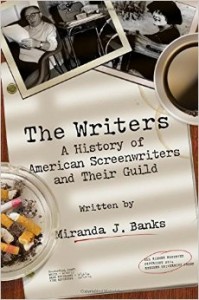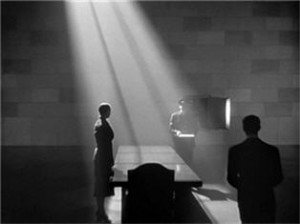Written for the Fall 2015 issue of Film Quarterly. — J.R.
The Writers: A History of American Screenwriters and
Their Guild by Miranda J. Banks
This is clearly a creditable, conscientious, intelligent, and
useful book, but I feel obliged to confess at the outset that
I don’t feel like I’m one of its ideal or intended readers. The
subtitle loosely describes its contents, but “A Business
History of Hollywood Screenwriters and Their Guild”
would come much closer to the mark, even if it might make
the book less marketable to me and some others. And the
unexceptional simplification of the title and subtitle is part of
what gives me some trouble: it’s the business of Hollywood,
after all, to convince the public that “American screenwriters”
and “Hollywood screenwriters” amount to the same
thing. And the moment that any meaningful distinction
between the two collapses, then the studios, one might argue,
have already won the battle.
I don’t expect my own bias about this matter to be shared
by many of Film Quarterly’s readers. Writers who blithely
and uncritically toss about terms like “Indiewood” designed
to further mystify the differences between studio work and
independent work probably don’t think they’re working for
the fat cats, but from my vantage point as a journalist who
thinks that these distinctions deeply matter, they’re the worst
kind of unpaid publicists. This isn’t to say that my own two
decades of weekly film reviewing for the Chicago Reader
weren’t bracketed by the same sort of market forces — only
that it’s important to provide some clarity about who is being
hustled, who (or what) is doing the hustling, and why.
Not that Miranda J. Banks is being in the least bit cagey
about her focus in The Writers. A key line in her Introduction
explains: “I define screenwriters as industry professionals
who write for screened entertainment, whether their
work appears on film, television, a video game, or streaming
video” (3). This obviously rules out a lot of screenwriters
who aren’t for one reason or another regarded as industry
professionals, and even though Banks plainly appears to be
on the side of all screenwriters, and not on the side of their
actual or prospective industry bosses, it’s still these bosses and
not their actual or potential employees who decide who is
and who isn’t an “industry professional.” And unavoidably,
this condition winds up determining much of the history
and workings (past, present, and future) of the Writers
Guild, however exalted as well as reasonable its aims might
be. The unreliability of a good many writers’ screen credits
as they’re given today — and the rapidity with which they
flash by in trailers, designed to satisfy neither the audience’s
curiosity nor the vanity of those writers lucky enough to be
named, but only the lawyers and other bureaucrats who are
running the show — is only one example of what I mean.
Both because of and in spite of this brutal fact, the story of
the Writers Guild that Banks recounts is a rocky and rather
torturous one, and not a tale in which the writers always or
necessarily emerge as the heroes. If, on the one hand, the formation
of the Motion Picture Academy was motivated by a
desire to steal thunder from the Guild and obfuscate as well
as undermine its power by replacing it in the mid-1930s by
what Banks correctly calls an “ersatz Guild” (32) — the
Screen Playwrights, a group that “plotted to gut the union
and lure away writers” (55) — the true-blue Guild, “by agreeing
to the MPAA’s loyalty requests . . . effectively aided in the
institution and enforcement of the blacklist” (105) for more
than two decades (1951–1973).
For all of Banks’s discernment in teasing out the paradoxes
inherent in the Guild’s formation and implementation, history
invariably gets written by the victors, so the Academy of
Motion Picture Arts and Sciences, however dubious its origins
and ongoing motivations, is far more respectable in contemporary
mainstream culture than the Guild itself, which is more apt to be
regarded as a special-interest group of lobbyists by comparison.
By the same token, figures such as Elia Kazan who cooperated
with the blacklist are viewed ambivalently at best, while the
studio heads who actually put it into practice are more likely to
be commemorated today as demigods and role models. Given
such a climate, it’s small wonder that Banks can classify
Citizen Kane as “classical [sic] Hollywood filmmaking . . .
at its finest in 1941,” along with How Green Was My Valley,
The Lady Eve, The Maltese Falcon, Dumbo, and
Sullivan’s Travels, regardless of how it was regarded both
inside and outside the industry in 1941 (74–75). But if Citizen
Kane with its unorthodox techniques was (or is) “classical”
Hollywood filmmaking, one can only wonder what her nonclassical
examples might be. (Easy Rider, perhaps?)
Banks, an assistant professor of visual and media arts at
Emerson College, draws on her own detailed interviews with
sixty screenwriters (including such figures as Mel Brooks and
Ring Lardner Jr.), as well as the archives of the Writers Guild
Foundation. Even though her text occasionally contains
overstatements — not quite “every studio head in Hollywood
during the studio system was Jewish” (24), as she credits Neal
Gabler for asserting — and stylistic infelicities, she has produced
a book that comes across as both careful and comprehensive,
at least to a layperson such as myself. She’s especially
informative about the different sort of labor struggles encountered
and resolved in writing for movies and television, and even the
significant differences between writing for television on the East
Coast and the West Coast.
For readers who find the subject of Hollywood as a business
fascinating, this book undoubtedly has many treasures to offer.
Banks even rounds off her study with two appendices —
twenty-one pages devoted to “Screenwriters and Selected
Credits” (complete with Academy and Emmy awards and
nominations and various Writers Guild of America and
Screen Writers Guild awards) (243–64), and four more to her
“Methodology” (265–68). But for someone like me who finds
business and career credits dull and unrewarding unless they’re
tied to other subjects and interests, not even the lucid and
considered prose of this book can prevent it from being a bit
of a slog. The exceptions are the terrific illustrations devoted to
pages from scripts, studio correspondence, and other ephemera.
These include, among other nuggets, a 1937 warning letter
by Jack Warner addressed to “all writers” about their lax
working hours, which reportedly led to Julius and Philip
Epstein coming up with the “perfect” ending to Casablanca at
8:30 AM (41), a light-verse parody of “Jabberwocky” by I.A.L.
Diamond that was published in the June 1947 issue of
The Screen Writer (66), and Frank S. Nugent penciling in the
dialogue “Let’s go home!” on page 140 of his script for The
Searchers (116). For me, they provide a series of oases in the
midst of Banks’s grand American subject, which usually — and
perhaps inevitably — turns out to be other people’s money.
BOOK DATA Miranda J. Banks, The Writers: A History of American
Screenwriters and Their Guild. New Brunswick, NJ: Rutgers University
Press, 2015. $34.95 cloth. 329 pages.


